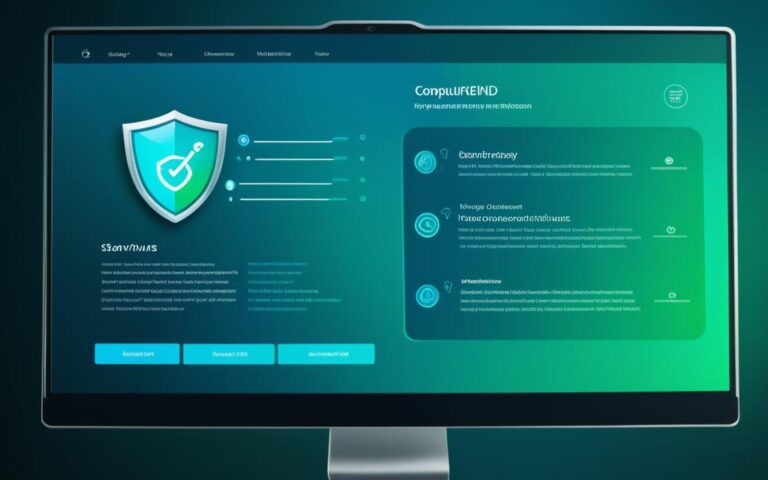The Future of Cybersecurity Cleanup Technologies
In the ever-evolving landscape of cybersecurity, staying ahead of cyber threats is crucial. As cybercriminals become more sophisticated, the need for advanced cybersecurity cleanup technologies has never been more important. In this article, we will explore the future of cybersecurity cleanup technologies and how ongoing tech advances are shaping the digital safety and data protection landscape.
From ransomware attacks to social engineering tactics, cyber threats continue to pose significant risks. As we delve into the future of cybersecurity, we will uncover the ongoing challenges businesses face and the solutions shaping the industry.
The cybersecurity workforce gap is a concerning issue, but managed security providers play a crucial role in bridging the divide. We will examine how these providers can help businesses reduce cyber risks while addressing the shortage of skilled security professionals.
Looking ahead, we will explore the trends that will define the future of cybersecurity. Incident preparedness, compliance with data privacy laws, and the growing importance of cyber insurance will all shape the strategies businesses adopt to protect their assets.
Artificial intelligence (AI) is revolutionizing cybersecurity, enabling advanced threat detection and behavioral analysis. We will discuss the role AI plays in safeguarding systems and identifying potential vulnerabilities.
Furthermore, automation is becoming increasingly crucial in threat response, with machine learning and automated workflows streamlining cybersecurity processes. We will explore the benefits and challenges associated with automation in the world of cybersecurity.
In conclusion, the future of cybersecurity lies in proactive security strategies, compliance, utilizing AI, and embracing automation. By staying informed about the latest tech advances and adopting robust cybersecurity measures, organizations can protect their valuable data and thrive in the digital age.
Cyber Threats That’ll Remain an Issue
Ransomware attacks pose a significant cybersecurity risk that is likely to persist in the future. With an increase in the number of threat actors and the frequency, scope, and volume of attacks, organizations must remain vigilant to protect their valuable data and assets.
Social engineering attacks, which exploit human error and manipulation, will also continue to pose a significant threat. Cybercriminals exploit psychological vulnerabilities to deceive individuals into divulging sensitive information or performing actions that compromise security.
In addition to traditional attack methods, cybercriminals may leverage artificial intelligence (AI) to further enhance their tactics. By utilizing AI algorithms and machine learning, attackers can automate and optimize their operations, making it more challenging to detect and defend against their malicious activities.
“Ransomware attacks and social engineering techniques remain potent threats to organizations and individuals alike. By exploiting vulnerabilities in technology and human behavior, cybercriminals can achieve their goals with devastating consequences.”
Ransomware Attacks
Ransomware attacks involve encrypting a victim’s data and demanding a ransom in exchange for its release. They typically target critical infrastructure, healthcare organizations, and businesses of all sizes. The consequences of a successful ransomware attack can include financial losses, reputational damage, and significant disruptions to operations.
Social Engineering
Social engineering techniques rely on psychological manipulation to deceive individuals into compromising security. Common tactics include phishing emails, impersonation, baiting, and pretexting. By exploiting human vulnerabilities, cybercriminals gain unauthorized access to systems, steal sensitive information, or trick individuals into performing actions that enable cyberattacks.
AI in Cybersecurity
Cybercriminals are increasingly using AI to enhance the effectiveness of their attacks. AI can automate various aspects of an attack, such as identifying potential targets, crafting customized phishing emails, or evading detection by security systems. Advanced AI algorithms can analyze large datasets to identify patterns and vulnerabilities, enabling attackers to customize their tactics and evade traditional cybersecurity defenses.
Stay Vigilant
In the face of these persistent threats, organizations must adopt robust cybersecurity measures to protect their digital assets. This includes implementing multi-layered defense systems, educating employees about potential risks, and regularly updating security protocols. With continuous monitoring and proactive cybersecurity strategies, businesses can mitigate the risks posed by cyber threats and safeguard their valuable data and resources.
Cybersecurity Workforce Gap and Managed Security Providers
The cybersecurity landscape is facing a significant challenge: a growing workforce gap. As cyber threats become more sophisticated, organizations require skilled security professionals to defend against cyberattacks and safeguard their digital assets.
Unfortunately, there is a shortage of cybersecurity experts, making it difficult for businesses to recruit and retain the necessary talent. This shortage not only increases the risk of cyber breaches but also adds pressure to organizations striving to comply with regulatory requirements.
To address this issue, many businesses are turning to managed security providers (MSPs) who specialize in cybersecurity services. These third-party providers offer a turnkey solution, delivering essential cybersecurity measures without the expenses and challenges associated with building an in-house team.
MSPs offer a range of services that contribute to cyber risk reduction and overall security posture. They provide proactive threat monitoring and incident response, vulnerability assessments, penetration testing, and security awareness training for employees. By partnering with MSPs, organizations can leverage the expertise and resources of dedicated security professionals to enhance their cybersecurity defenses.
In addition to providing essential security services, MSPs offer several advantages:
- Cost-effectiveness: Outsourcing cybersecurity to MSPs can result in cost savings compared to hiring and training an in-house team.
- 24/7 monitoring and support: MSPs ensure continuous monitoring and swift response to potential threats, minimizing the risk of security breaches.
- Access to advanced technologies: MSPs leverage state-of-the-art cybersecurity tools and technologies that may be beyond the reach of individual organizations.
- Expertise and scalability: MSPs are staffed with skilled cybersecurity professionals who possess deep knowledge and experience in managing diverse security challenges. They can easily scale their services to meet the evolving needs of organizations.
While MSPs offer valuable services and help bridge the cybersecurity workforce gap, it’s essential for organizations to establish strong partnerships with reputable providers. Thorough vetting of MSPs is crucial to ensure they align with the organization’s security requirements, industry regulations, and risk tolerance.
In conclusion, the cybersecurity workforce gap poses a significant risk to organizations, hindering their ability to effectively combat cyber threats. Managed security providers offer a viable solution, enabling businesses to enhance their cybersecurity posture, reduce risk, and achieve peace of mind. By leveraging the expertise of MSPs, organizations can focus on their core competencies while ensuring their digital assets are protected by dedicated professionals.
Trends in Future Cybersecurity
The future of cybersecurity is rapidly evolving with the constant advancement of digital threats. In order to stay ahead and effectively protect sensitive data and systems, organizations must be prepared for the challenges that lie ahead. This section will explore some of the key trends that will shape the future of cybersecurity, including incident preparedness, compliance, cyber insurance, cloud-based services, and the role of artificial intelligence (AI) in cybersecurity.
Incident Preparedness and Response
As cyber threats become more sophisticated, incident preparedness and response will become paramount for organizations. Proactive planning and employee education will play a crucial role in mitigating the impact of cyber attacks. By developing incident response plans, conducting regular cybersecurity training, and simulating various attack scenarios, businesses can enhance their ability to effectively detect, contain, and respond to cyber incidents.
Compliance with Data Privacy Laws
Data privacy laws are continuously tightening, placing greater emphasis on compliance within the cybersecurity landscape. Organizations will need to ensure they meet the regulatory requirements set forth by governing bodies. This includes implementing robust security measures, conducting regular audits, and demonstrating a commitment to protecting customer and user data.
Cyber Insurance Assessments
The rise of cyber insurance policies will drive a higher demand for cybersecurity assessments. Insurance providers will require organizations to undergo thorough evaluations to determine their level of risk and preparedness. These assessments will help organizations identify vulnerabilities, implement necessary controls, and demonstrate their commitment to cybersecurity best practices.
Targeting of Cloud-Based Services
As businesses increasingly rely on cloud-based services, cyber threats targeting these platforms will also grow. Cloud security will become a top priority, requiring robust protection measures and ongoing monitoring of cloud environments. Organizations must implement multi-layered security controls to safeguard their data and applications from unauthorized access and breaches.
The Role of AI in Cybersecurity
Artificial intelligence (AI) will continue to play a significant role in improving cybersecurity capabilities. AI-powered solutions can help identify potential threats, analyze patterns, and detect anomalies in real-time. They can also automate cybersecurity tasks, enhance incident response times, and provide proactive threat intelligence. With the ability to adapt and learn from emerging threats, AI can strengthen overall cybersecurity defenses.
Ultimately, staying ahead in the ever-changing landscape of cybersecurity requires organizations to embrace incident preparedness, prioritize compliance, invest in cyber insurance assessments, secure cloud-based services, and leverage AI technologies. By adopting these trends, businesses can enhance their cybersecurity posture and successfully navigate the future of digital security.
AI and the Future of Cybersecurity
Artificial intelligence (AI) is revolutionizing the field of cybersecurity, empowering organizations to stay one step ahead of evolving threats. Through advancements in AI technologies such as threat detection, behavioral analysis, predictive analytics, and natural language processing (NLP), cybersecurity professionals can effectively safeguard sensitive data and mitigate the risks posed by cybercriminals.
AI models play a crucial role in identifying patterns and anomalies associated with cyber threats, enabling rapid detection and response. By analyzing user and system behavior, AI algorithms can detect suspicious activities and proactively predict vulnerabilities, providing organizations with valuable insights for bolstering their security posture. These AI-powered systems can also analyze textual data, leveraging NLP techniques to identify phishing attempts and recognize suspicious content, further enhancing threat intelligence capabilities.
Threat detection is one area where AI has made significant strides in cybersecurity. AI-powered algorithms can process vast amounts of data from various sources, including network logs, user behavior, and system events, to identify potential malicious activities. By constantly learning and adapting, AI models can evolve alongside emerging threats, ensuring that cybersecurity measures remain effective and up to date.
Behavioral analysis is another critical aspect of AI in cybersecurity. Using machine learning techniques, AI can analyze user behavior patterns and identify deviations that may indicate a potential security breach. Combining this analysis with predictive analytics allows organizations to take proactive measures to prevent attacks before they occur.
Predictive analytics powered by AI enables organizations to forecast potential vulnerabilities and take preemptive actions. By analyzing historical data and identifying patterns, AI models can predict future cyber threats and help organizations allocate resources effectively and implement proactive security measures. This predictive approach allows for a strategic and proactive cybersecurity strategy, reducing the likelihood and impact of cyber-attacks.
Moreover, NLP empowers AI systems to analyze and understand human language, enhancing their ability to detect and respond to cybersecurity threats that leverage social engineering tactics. By deciphering the semantics and intent behind conversations, AI can identify and mitigate potential risks introduced through social engineering or other forms of interaction.
The integration of AI in cybersecurity not only strengthens threat detection and response capabilities but also enables organizations to automate certain security workflows. By offloading manual tasks to AI-powered systems, cybersecurity teams can focus on more strategic initiatives while benefiting from the speed and efficiency of automation.
The future of cybersecurity lies in leveraging AI to continuously analyze and adapt to emerging threats. By harnessing the power of AI for threat detection, behavioral analysis, predictive analytics, and NLP, organizations can strengthen their defenses, mitigate risks, and protect sensitive data in an increasingly complex cyber landscape.
Automation and Threat Response
Automation plays a crucial role in threat response, leveraging the power of machine learning algorithms to detect and respond to suspicious activity efficiently. With the increasing volume and complexity of cyber threats, manual threat response processes are no longer sufficient. Automated workflows equipped with intelligent algorithms enable organizations to stay ahead of evolving threats, protecting their digital assets and ensuring data integrity.
One significant aspect of automation in threat response is machine learning. By training algorithms on vast amounts of historical data, these systems can identify patterns, anomalies, and potential indicators of compromise. This allows them to quickly flag and respond to potential threats in real-time, reducing the time it takes to identify and mitigate risks.
Automated workflows further enhance threat response by streamlining and integrating various security processes. These workflows can be designed to automatically trigger responses when specific threat indicators are detected. For example, if a system detects an unauthorized access attempt, it can automatically isolate the affected device, block the malicious IP address, and alert the security team for further investigation.
“Automation allows organizations to neutralize threats swiftly and efficiently without requiring constant manual intervention,” said Sarah Thompson, a cybersecurity expert at XYZ Corporation. “By automating threat response processes, businesses can significantly improve their incident response time and minimize potential damages.”
Efficient threat response automation goes beyond reactive measures and can also utilize proactive strategies. Intelligent tools, such as ChatGPT, can provide contextual information to security analysts, recommend appropriate mitigations, and even generate automated responses based on pre-defined playbooks and threat intelligence. This enables security teams to make well-informed decisions and respond effectively to emerging threats.
Reducing False Positives with Automation
False positives, or the incorrect identification of benign activities as threats, can create unnecessary burden for security teams and result in wasted resources. Automation plays a vital role in reducing false positives, allowing analysts to focus on genuine threats and high-priority incidents.
Advanced machine learning algorithms can be trained to analyze vast amounts of data and accurately differentiate between genuine threats and benign activities. By continuously learning from historical data and user feedback, these algorithms improve their accuracy over time, ensuring that false positives are kept to a minimum.
“False positives not only waste valuable time and resources, but they can also impact the overall efficiency of a security team,” emphasized James Wilson, Director of Cybersecurity at ABC Solutions. “With automation and machine learning, we can fine-tune our threat detection algorithms and significantly reduce false positives, allowing us to prioritize genuine threats and respond effectively.”
To further enhance accuracy, automation systems can integrate data from various sources, allowing for more comprehensive analysis. By considering multiple data points and performing cross-referencing, these systems can validate alerts and reduce the chances of false positives, thus streamlining the incident response process.
This comprehensive and context-aware threat response approach, empowered by automation, enables organizations to detect and address cyber threats rapidly and effectively, mitigating the potential impact on their operations and reputation.
| Benefits of Threat Response Automation | Challenges in Implementing Automation |
|---|---|
|
|
Implementing threat response automation requires careful planning and consideration of various factors. Organizations must assess their existing security infrastructure, identify suitable automation solutions, and ensure seamless integration with their existing systems and tools.
While the implementation process may present challenges, the benefits far outweigh the initial hurdles. The ability to respond swiftly to threats, reduce false positives, and achieve greater operational efficiency makes threat response automation a vital component of a robust cybersecurity strategy in today’s complex threat landscape.
Conclusion
Embracing the future of cybersecurity requires a proactive approach. Organizations must prioritize the implementation of proactive security strategies to stay one step ahead of emerging threats. Compliance with regulations plays a crucial role in ensuring data protection and maintaining the trust of customers and stakeholders. By leveraging the power of AI for threat detection and response, organizations can enhance their cybersecurity capabilities and minimize the impact of cyber attacks.
Automation is another key aspect of the future of cybersecurity. By automating cybersecurity processes, organizations can streamline their operations, increase efficiency, and reduce human error. Tools powered by AI, such as machine learning algorithms and ChatGPT, facilitate threat response and provide valuable insights for better decision-making. Additionally, automation helps organizations in scaling their cybersecurity efforts and managing the growing complexity of cyber threats.
As the digital landscape evolves, organizations must be proactive in adapting their cybersecurity strategies. By embracing the future of cybersecurity through proactive security measures, compliance, AI, and automation, businesses can ensure the protection of their data and assets. With a secure digital future, organizations can confidently navigate the ever-changing threat landscape and safeguard their operations, customers, and reputation.












